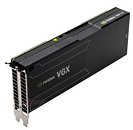- Joined
- Oct 9, 2007
- Messages
- 47,695 (7.42/day)
- Location
- Dublin, Ireland
| System Name | RBMK-1000 |
|---|---|
| Processor | AMD Ryzen 7 5700G |
| Motherboard | Gigabyte B550 AORUS Elite V2 |
| Cooling | DeepCool Gammax L240 V2 |
| Memory | 2x 16GB DDR4-3200 |
| Video Card(s) | Galax RTX 4070 Ti EX |
| Storage | Samsung 990 1TB |
| Display(s) | BenQ 1440p 60 Hz 27-inch |
| Case | Corsair Carbide 100R |
| Audio Device(s) | ASUS SupremeFX S1220A |
| Power Supply | Cooler Master MWE Gold 650W |
| Mouse | ASUS ROG Strix Impact |
| Keyboard | Gamdias Hermes E2 |
| Software | Windows 11 Pro |
Engineers and design professionals will be able to work anywhere on virtually any device and still have access to the computing and graphics performance of a GPU-powered workstation, with today's launch of the cloud-based NVIDIA VGX K2 GPU. Built on the NVIDIA Kepler architecture -- the world's fastest, most efficient GPU architecture -- VGX K2 adds unprecedented workstation capabilities to the NVIDIA VGX platform, which was announced earlier this year.
The NVIDIA VGX platform utilizes the GPU to allow enterprises to efficiently deliver virtualized workstation performance and capabilities -- including rich multimedia and 3D graphics -- to users on smartphones, tablets or PCs. Its VGX K2 board, which includes two workstation-class GPUs, enables enterprises to increase user density without sacrificing performance or application compatibility.

Other key benefits of NVIDIA VGX K2 include:
NVIDIA and Citrix Expand Enterprise Presence of Workstation-Class Virtual Desktops
Citrix XenDesktop with HDX 3DPro uses NVIDIA VGX technology to deliver a faster, more interactive user experience. In combination with Citrix XenDesktop and Citrix XenApp, the NVIDIA VGX K2 board provides users full compatibility and performance of all their graphics and GPU computing-intensive applications. In addition, the ecosystem of Citrix Ready partners around HDX 3D will be able to use VGX K2 to provide workstation-class performance.
"In our increasingly global and mobile economy, companies are looking more and more to desktop virtualization as a critical solution, and we're working closely with NVIDIA to offer the most advanced virtualized user experience on the market," said Krishna Subramanian, vice president of marketing and partner engagement at Citrix. "XenDesktop with NVIDIA VGX acceleration aims to deliver workstation-class performance to the most demanding users in enterprises, while also increasing user density in their data centers."
Supporting Partner Quote
"NVIDIA's GPU virtualization technology builds on and accelerates Cisco's vision of delivering virtual desktops and rich-media applications through the cloud, and helps to enable enterprise customers to deploy simple, scalable and highly secure virtualization solutions," said Satinder Sethi, vice president at Cisco, an NVIDIA technology partner.
Availability
The NVIDIA VGX K2 platform for virtual workstations is expected to be available from leading server OEMs starting in early 2013. More information is available at www.nvidia.com/vgx.
View at TechPowerUp Main Site
The NVIDIA VGX platform utilizes the GPU to allow enterprises to efficiently deliver virtualized workstation performance and capabilities -- including rich multimedia and 3D graphics -- to users on smartphones, tablets or PCs. Its VGX K2 board, which includes two workstation-class GPUs, enables enterprises to increase user density without sacrificing performance or application compatibility.

Other key benefits of NVIDIA VGX K2 include:
- Faster interactivity: With 4 GB of graphics memory per GPU, VGX K2 ensures that graphics-intensive design and content-creation applications run with ease.
- Low-latency remote display: Patent-pending remote display technology minimizes the lag traditionally associated with virtual desktop computing.
- Data center power efficiency: Using SMX, a revolutionary streaming multiprocessor, VGX K2 provides unsurpassed performance per watt for enterprise data centers.
NVIDIA and Citrix Expand Enterprise Presence of Workstation-Class Virtual Desktops
Citrix XenDesktop with HDX 3DPro uses NVIDIA VGX technology to deliver a faster, more interactive user experience. In combination with Citrix XenDesktop and Citrix XenApp, the NVIDIA VGX K2 board provides users full compatibility and performance of all their graphics and GPU computing-intensive applications. In addition, the ecosystem of Citrix Ready partners around HDX 3D will be able to use VGX K2 to provide workstation-class performance.
"In our increasingly global and mobile economy, companies are looking more and more to desktop virtualization as a critical solution, and we're working closely with NVIDIA to offer the most advanced virtualized user experience on the market," said Krishna Subramanian, vice president of marketing and partner engagement at Citrix. "XenDesktop with NVIDIA VGX acceleration aims to deliver workstation-class performance to the most demanding users in enterprises, while also increasing user density in their data centers."
Supporting Partner Quote
"NVIDIA's GPU virtualization technology builds on and accelerates Cisco's vision of delivering virtual desktops and rich-media applications through the cloud, and helps to enable enterprise customers to deploy simple, scalable and highly secure virtualization solutions," said Satinder Sethi, vice president at Cisco, an NVIDIA technology partner.
Availability
The NVIDIA VGX K2 platform for virtual workstations is expected to be available from leading server OEMs starting in early 2013. More information is available at www.nvidia.com/vgx.
View at TechPowerUp Main Site





 +1
+1

 so you agree with the fact i stated then Amd had already done this so the first is unfounded.
so you agree with the fact i stated then Amd had already done this so the first is unfounded. factboy more like
factboy more like
 with your hyper defensive malarkyins
with your hyper defensive malarkyins , as that one missleads.
, as that one missleads.